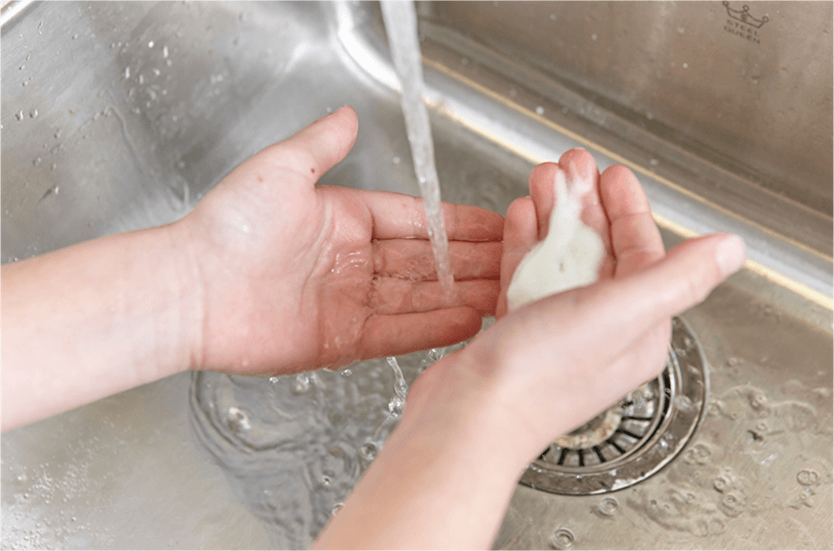Help students learn the importance of personal hygiene and safe food handling to reduce the risk of food poisoning.
Food can become contaminated by harmful bacteria, viruses and parasites while it is being handled and prepared. The Government of Canada reports that over 4 million Canadians suffer from food poisoning each year (also referred to as food-borne or food-related illness). Symptoms can include nausea, vomiting, diarrhea, stomach pain and fever. Most people recover quickly without long-term effects, but serious complications can occur in some cases, including death.
Schools provide an ideal setting to teach students about safe food handling. When they understand how to clean, cook, chill, and separate foods properly, they can help reduce the risk of food poisoning.
Germ spreader activity
Do this activity with students to explain how germs spread and how proper handwashing helps to prevent food poisoning.
Supplies needed: canola oil and cinnamon
- Ask for six student volunteers to be the “germ spreaders”.
- Give each student ½ tsp (2 mL) of canola oil to rub all over the front and back of their hands.
- Sprinkle a little bit of cinnamon on their hands and ask them to rub it all over.
- Explain that the canola oil represents the natural oil on the skin and the cinnamon represents germs that stick to our skin.
- Invite students to shake hands with their classmates. This will show how germs can spread.
- Ask students to wash their hands with soap and warm water. Note how long it takes to remove the cinnamon. This highlights how thorough handwashing is needed to remove germs as well.
Personal hygiene
Review these personal hygiene points with students before starting any cooking activity.
- Tie hair back and avoid touching your face, mouth or hair during cooking.
- Cough or sneeze into your elbow.
- Wash your hands before you start cooking. Download the Cooking technique illustrations from TeachNutrition.ca to learn about proper handwashing.
- Avoid touching objects like phones, pens, pencils or school bag during cooking.
- Wash hands during cooking, especially after sneezing, touching face or going to the washroom.
- Use a waterproof bandage and a glove if you have an open wound on your hand. If there are no gloves, ask a classmate to help prepare the food.
Good cleaning practices
- Clean kitchen counters or tables that will be used during the activity.
- Wash all vegetables and fruit under running water before using them. Use a scrub brush to clean those with thick skin such as potatoes, carrots, melons, etc. Make sure your scrub brush is cleaned after each use.
- Keep measuring spoons and measuring cups clean after you measure out your ingredients. Place them on a small plate rather than putting them on the table.
- Keep raw foods like meat and poultry separate from foods that are cooked or ready-to-eat. Use different cooking tools for raw and cooked foods.
- Use different coloured cutting boards e.g., one for produce or breads and another one for raw meat, poultry, fish and seafood.
- Clean as you go. Wipe up any spills using paper towels or dish cloths. Change dishcloths each day and avoid using sponges since they are difficult to keep clean and free of bacteria.
Storing foods at safe temperatures
- Keep cold foods cold and hot foods hot, so that your food never reaches the "temperature danger zone". Avoid having foods in the "temperature danger zone" between 4°C to 60°C (40°F to 140°F). This is where bacteria can grow quickly and cause food poisoning.
- Store perishable foods in the fridge within 2 hours of being at room temperature. Reduce the time to 1 hour at room temperature on warmer days.
- Store all perishable foods in a fridge or in a cooler with ice packs until you need to use them. They should be stored at 4°C (40°F) or lower to keep them out of the temperature danger zone.
- Refrigerate fresh fruits and vegetables that are pre-cut and ready-to-eat.
- Keep raw meat, poultry, fish, seafood and dairy cold. Place them in the fridge or freezer as soon as you get home.
- Put raw meat or poultry in a sealed bag or container and place on the bottom of the cooler or on the lowest shelf in the fridge. This prevents raw juices from dripping on other foods.
- Keep hot foods at or above 60°C (140°F).
Safe sampling
Part of cooking is sampling and enjoying the food you have prepared.
- Wait until food is fully cooked before sampling to prevent food borne illness.
- Prevent cross contamination when sampling! Place a small amount of food on a clean spoon, plate or in a cup to taste test just before serving. Place the used spoon in the sink or dishwasher. Never reuse a sample spoon.
- Never lick fingers during cooking.
Download the Classroom cooking activity from TeachNutrition.ca. Use this kit to guide your class through cooking activities that can be done in any classroom. No kitchen needed! The kit includes an equipment checklist, no-bake recipes to practise cooking skills and student worksheets on kitchen tools and proper measuring.

